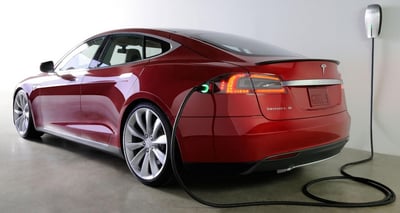Wireless Smart Power Cables for Data Center Power Monitoring
Have you already gone wireless or are you still dealing with cables? A different approach to integrated power and environment monitoring in data...
1 min read
![]() Paul Bieganski
:
Jul 14, 2016 10:00:00 AM
Paul Bieganski
:
Jul 14, 2016 10:00:00 AM

Electric cars are here. If you don't drive one yet, chances are you will before the end of the decade. An electric car is basically a computer (multiple computers really) with a bunch of batteries and an electric motor or two on four wheels. Just like your average computer, it consumes electrical energy. Have you ever wondered how far your average rack of servers could take you if it was a Tesla?
We did the math.
Let's take an average server consuming 400W of power per hour at average load. Depending upon your PUE, it is probably indirectly responsible for another 50-400W of power for cooling purposes. Let's assume your PUE is pretty good and call it 100W for cooling. That gives you a total consumption of 500W per hour. If you run it for a day you consume 500W x 24 hours = 12,000Wh = 12kWh of energy.
A Tesla Model S will consume about 300Wh per mile (186Wh per km). This means your single server's daily energy could take you about 12,000 / 300 = 40 miles. If that's about how far you commute to work, just one of your servers could take care of your daily commute. If you have 10,000 servers in your data center, you could power the daily commute of 10,000 people.
Let's go slightly bigger and consider an average rack consuming about 6,000W (6kW) of power. If you add the additional power consumed for cooling (assuming 25%), you arrive at a total of about 7,500W or 7.5kW. Over 24 hours this translates to 7,500W x 24 hours = 180,000Wh = 180kWh. At 300Wh per mile, this would allow you to drive about 180,000 / 300 = 600 miles. So next time you look at that row of cabinets imagine a row of Teslas -- each putting in a very full day of driving.


In our example we used industry average values. If you are monitoring your power, you can plug in your own numbers and find out how far your servers can take you. If you're not monitoring your power, email sales@packetpower.com. We've got the easiest, most cost-effective solution to help you do that ... and more.
Maybe we'll add a page in our EMX energy portal to show how far you could have driven on all that compute power.
Safe driving!

Have you already gone wireless or are you still dealing with cables? A different approach to integrated power and environment monitoring in data...
![Installing Packet Power Smart Power Cables [VIDEO]](https://www.packetpower.com/hubfs/Blog/Packet%20Power_Smart%20Power%20Cable%20Install.jpg)
Monitoring the power usage of any device that with a plug is simple with Packet Power’s Smart Power Cables. Just how easy is it? This short video...

Our customer SecureData 365 offers these comments on why they use Packet Power's monitoring solution: SecureData 365 (www.securedata365.com) operates...